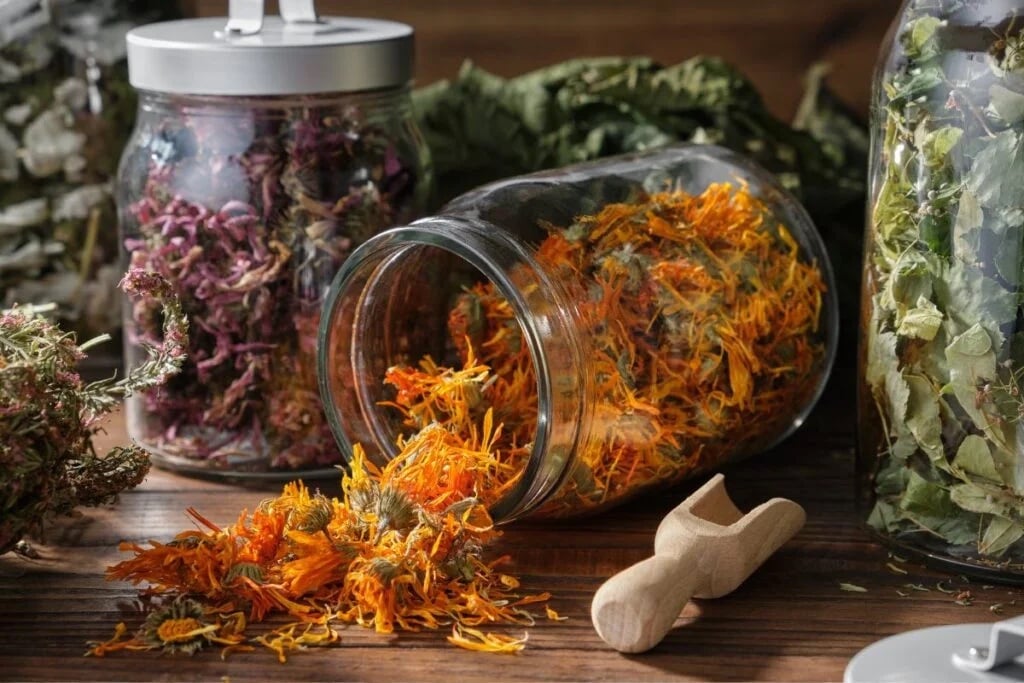Much could be said about the benefits of calendula also known by another name as pot marigold, well recognised for its vibrant yellow and orange flowers. This plant can certainly be relied on for many aspects of life. Calendula tea can be helpful both by drinking it and by using it externally in various compresses. In addition, there are many other uses for this plant. These include various decoctions, ointments and even decoctions.
It is encouraging that not only folk medicine recognises the benefits of calendula these days, but also scientists have shown in their research that it is a really good medicinal plant and very useful.
Briefly about calendula
Calendula is a remarkably adaptable plant that can thrive in a variety of soil types and geographic zonesg, it likes sunny places, delights with its bright flowers in flower gardens and is used to treat a wide range of diseases. Its bright yellow and orange flowers are used to make the health-giving calendula tea.
The flowers can be picked every 2-3 days throughout the summer and less frequently in autumn. The flowers that have the most medicinal properties are those that have just opened. When picking, the plant branches out to produce more flowers. Drying should be done after spreading in a well-ventilated room where the flowers are not exposed to direct sunlight. If you are drying marigold flowers in an oven or tumble dryer, it is a good idea to keep the temperature at around 40 °C to preserve their beneficial properties. Suitable for consumption for 2 years.
In summer, marigolds were used to help people predict the day’s weather. If the flower heads of marigolds do not open in the morning, it means that rain is on the way, and if the flowers open well before seven o’clock, the ancients would look forward to a really nice day.
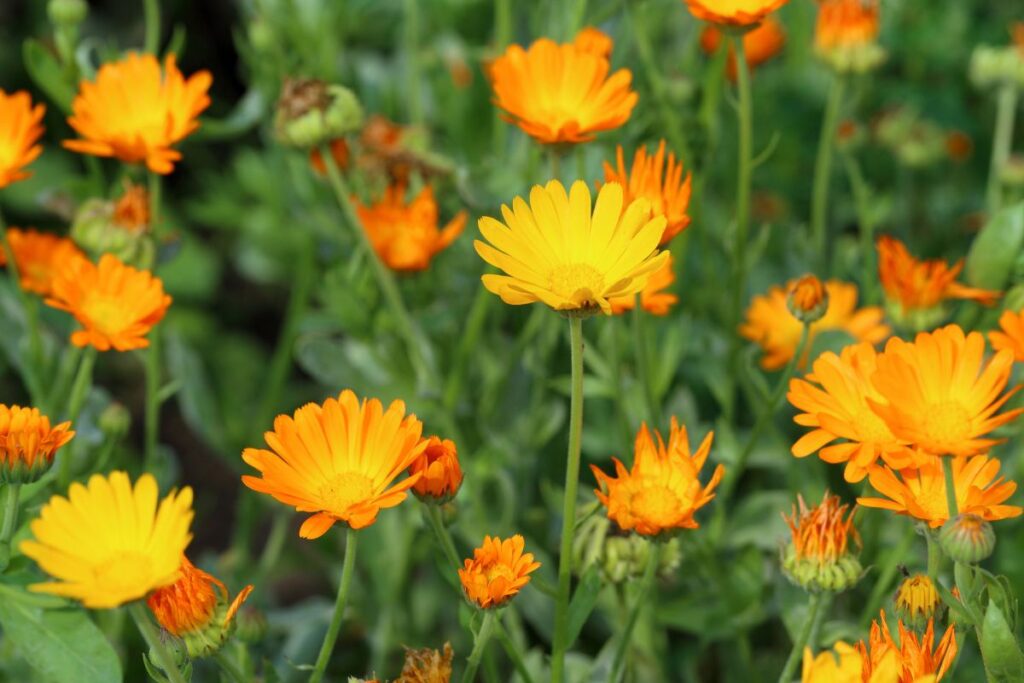
Gathering and drying medicinal raw materials
All the aerial part of the marigold is used for medicinal purposes, but it is the inflorescences that contain the most useful components. Marigold flowers are harvested during the flowering season from mid-June to early October. Do not pick marigolds at the first frost – the plants lose their valuable properties very quickly in the cold.
Choose a dry, warm and sunny day to pick marigolds. Pick the flowers at midday, preferring those that are fully open.
Like all herbs, marigolds should be dried in closed verandas, balconies, attics or in the open air in the shade. It is important that the marigolds you are drying are not exposed to moisture or direct sunlight.
Spread the marigold blossoms in a thin layer (no more than 20 mm) on the material. Shake the marigolds occasionally and turn them over. This will speed up drying and prevent deterioration. Marigolds can also be dried in the oven at 50 °C.
When well dried, the flower blossoms should crumble when rubbed. When properly prepared, the plant material has a faint specific aroma and a bitter-sweet taste. Dried marigolds can be stored for up to 1 year in cloth or paper bags.

Benefits of calendula tea
Despite its beauty as a flower, with its bright orange flowers full of carotene, calendula also contains organic acids, resins, flavonoids, trace elements, essential oils and other biologically active antiseptic and anti-inflammatory substances. The health benefits of calendula tea are unquestionable and it is suitable as a remedy for a wide range of diseases:
- Gastrointestinal disorders: stomach and duodenal ulcers, as well as gastric and intestinal malignancies. Calendula has anti-inflammatory compounds such as tumour necrosis factor alpha (TNFα). Although inflammation is a normal reaction in our body, chronic inflammation is linked to many diseases, including obesity, metabolic syndrome and type II diabetes.
- It can help with women’s diseases and other ailments. Calendula is said to relieve menstrual cramps. Calendula compresses can also relieve sore nipples during breastfeeding.
- It soothes tired eyes and improves eyesight – the infusion is used for compresses.
- For jaundice – drink two cups a day.
- For dental and throat diseases, rinse mouth and throat with calendula infusion. One of the most common oral diseases is gingivitis. In a 6-month study of 240 people with gingivitis, those given calendula mouthwash had a 46% reduction in inflammation.
- Improves heart function. Calendula’s anti-inflammatory and antioxidant effects may reduce the risk of heart attack. However, this effect was observed in one test-tube study using extremely high doses of calendula.
- Improves gallbladder function.
- Suitable for oily hair and dandruffy scalp, reduces sebum production and is recommended for hair loss.
- For the kidneys and urinary tract, it is suitable for both prevention and treatment. Calendula tea is recommended if urination has become more frequent or painful.
- May reduce muscle fatigue. A study shows that calendula extract reduces muscle fatigue caused by exercise. However, it is important to note that the study used extracts from two other plants, so it is difficult to determine how calendula works in isolation.
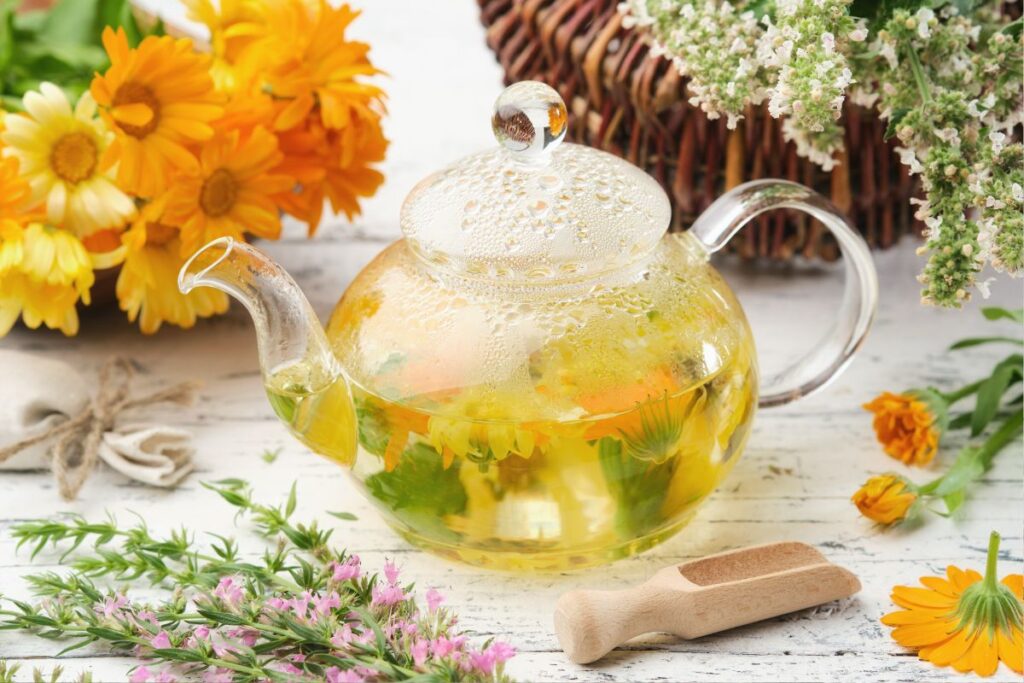
Calendula tea – prevention of liver disease
It is not only the marigold flowers and leaves that are used to treat liver disease and to detoxify the liver . It is important to drink the tea without sugar.
In a study, calendula was shown to have hepatoprotective (liver-protective) properties against aflatoxin-induced liver damage due to its free radical scavenging and anti-inflammatory properties, depending on the dose. Aflatoxins are carcinogenic substances, even small amounts of which can cause liver cancer.
Another test-tube study showed that calendula extract inhibits the growth of leishmania, the parasite that causes leishmaniasis, a disease that can cause skin lesions or damage to internal organs – primarily the liver, spleen, etc.

Calendula tea for various skin lesions and diseases
Calendula promotes tissue regeneration, activates blood circulation, helps collagen production in the damaged area and speeds up the skin’s recovery process after surgery or other injuries. According to herbalist Jeanne Rouz, calendula infusion can be used to treat skin problems, as well as to wash away watery eyes, sensitive skin or skin affected by dermatitis. In a 12-week human study, 72% of participants treated with calendula extract showed complete healing of venous leg ulcers. Another 30-week study involved a diabetic adult with foot ulcers. When they were treated daily with calendula spray, 78% of the participants had complete healing of their foot wounds.
Insect bites can be moistened with calendula tea or applied with a special calendula ointment (see recipe below). Calendula tea will also help babies to soothe irritated skin from nappies.
Calendula tea may have anti-cancer effects
Research shows that the antioxidants in calendula may have anti-cancer effects. Antioxidants in calendula flavonoids and triterpenes have been shown to fight leukaemia, melanoma, colon and pancreatic cancer cells. Other studies show that calendula extract activates proteins that kill cancer cells while blocking other proteins that would otherwise prevent cell death.
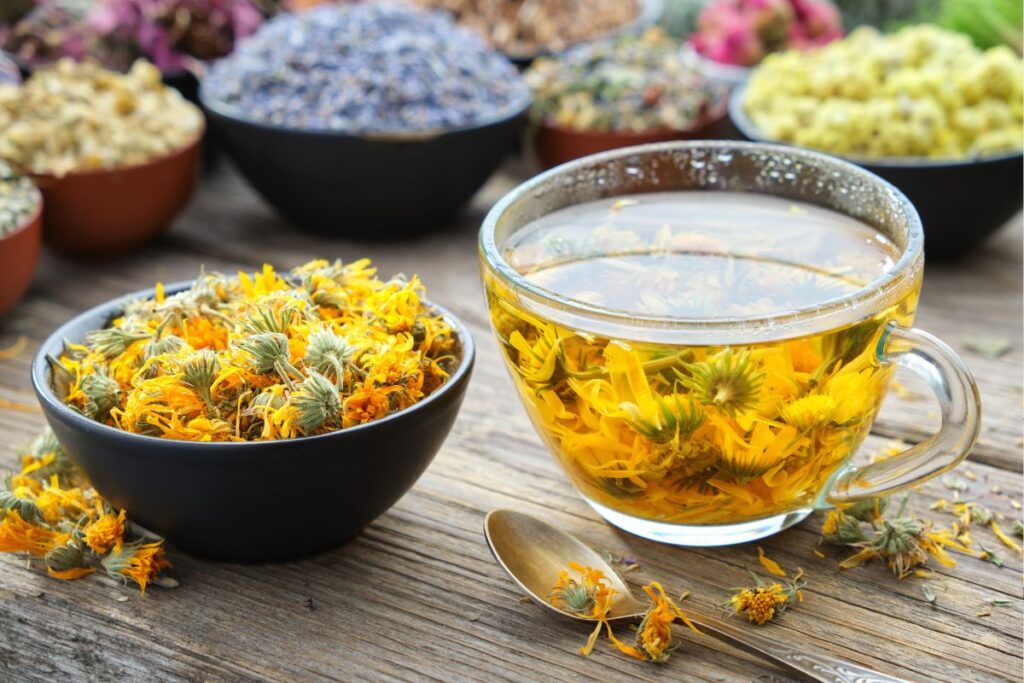
Calendula may have antifungal and antimicrobial properties
Calendula extract has antifungal and antimicrobial properties. It kills some bacteria, most notably staphylococci and streptococci. In one test-tube study, calendula blossom oil was shown to be effective against as many as 23 strains of Candida, a fungus that can cause oral, vaginal and skin infections. Calendula extract also inhibits leishmaniasis, a disease that can cause skin wounds or damage to internal organs such as the spleen and liver.
Another test-tube study showed that calendula extract inhibits the growth of leishmania, the parasite that causes leishmaniasis, a disease that can cause skin sores or damage to internal organs, particularly the liver, spleen and others.
How to make calendula tea
It’s very quick to make a healing tea with calendula. Place one teaspoon of calendula flowers in a standard-sized cup or glass (250 ml) and cover with boiling water. Leave to infuse and drink as it cools. You can flavour the tea with honey or lemon.
Calendula tea – for fertility
If you are unable to conceive and the cause is inflammation of the reproductive and internal organs, then try an old folk recipe for calendula and heather tea. The method of preparation is the same as above – 1 teaspoon of the herb is brewed in a glass of boiling water and drunk 2 to 3 times a day, a whole glass before meals.

Calendula and St. John’s Wort Cough Tea
The flavonoids in calendula are excellent for relieving inflammation of the upper respiratory tract and coughs. Calendula and St John’s wort tea is an excellent remedy for coughing fits.
The preparation of this tea is very simple. Just take a tablespoon each of calendula and St John’s Wort flowers and pour 400 ml of boiling water over them. Wrap the container with the infused tea in a towel and leave it for 30 minutes. Drain before drinking.
Drink the tea during the day. You can also use it to gargle a sore throat.
How often to drink calendula tea
The recommended daily dose of calendula tea is 100-150 ml 3 times a day. Excessive doses of the tea can cause drowsiness and stomach pains, as well as lowering blood pressure. When using calendula tea for therapeutic purposes, the course of treatment should be individually prescribed by the doctor for each patient.
Calendula tea should always be drunk warm, 10-15 minutes before meals.

Miraculous calendula ointment
Calendula can be used to make a medicinal ointment to help healing ulcers, fistulas, inflamed veins and damaged skin such as chapped, cracked, blistered or burnt skin. Calendula ointment has anti-inflammatory, regenerative and soothing properties. It can also be used for breast tumours, even malignant ones, and you can use the leftovers from making the ointment to make a breast compress.
This ointment is easy to make at home.
- Heat 250 g of lard or goose fat in a pan (shea butter is fine for vegans).
- Add two handfuls of calendula flowers, leaves and stems to the hot fat.
- When the mixture starts to foam, stir well, remove from the heat and leave to cool overnight covered.
- The next day, reheat the mixture and strain it through a fine sieve, a linen strainer or cheesecloth, squeezing out as much of the remaining juice as possible from the herbs.
- Pour the ointment into screw-top jars.

Calendula infusion
Calendula infusion will help in the treatment of stomach and intestinal diseases, arrhythmia, hypertension, oncological diseases, insomnia and shortness of breath.
It is very easy to make a calendula infusion:
- Put 20 grams of calendula flowers in a dark glass bottle and pour in 100 ml of alcohol.
- store the bottle in a dark place for 2 weeks and then strain it.
Use of calendula decoction:
- Take 20 drops 3 times a day before meals.
- The decoction, diluted in boiled water (1 teaspoon of decoction per glass of water), can be applied to burns, ulcers, sores, pimples, acne, wounds, and as a gargle for mouth and throat.
- Diluted calendula decoction (1 teaspoon of the decoction per glass of water) should also be used as a poultice for wounds, bruises, muscle strains, sprains, bedsores, lumps, abscesses and malignant tumours.
Calendula decoction
A decoction of calendula is used to treat the skin. take 2 tablespoons of dried calendula flowers and boil in 200 ml of water for 10 minutes. Strain the herbs when cool.
The decoction can be used to make poultices for: insect bites, burns, frostbite, fungal infections and other skin diseases. The antioxidants and anti-inflammatory substances in calendula ensure rapid results.

Calendula, burdock and hops decoction to strengthen hair
To stop hair loss or simply to strengthen your hair so that it looks shiny and healthy, you can prepare a decoction of calendula flowers, burdock root and hop cones.
- Crush one tablespoon each of burdock root, calendula and hop cones into equal parts.
- Pour 500 ml of water over this herbal mixture and boil for 15 minutes.
- Strain the decoction, dilute with water and wash 2 times a week or rub on the scalp 2 times a week.
- Prepare a fresh decoction for each wash or rub – this is the one that will have the strongest healing power.
Calendula tea for a relaxing bath
To cleanse the body and the senses during the waxing moon weekend, do the following: prepare a cup of fresh or dried calendula petals (for the bath), a cup of calendula tea (for the drink), a glass of Epsom salt (you can opt for ordinary sea salt), a candle and water. Fill the bath with warm water and add fresh or dried calendula flowers to the bath. Light the candle. Lie back in the bath and put on your favourite music. Drink some calendula tea followed by water. Repeat the treatment on weekends during the waxing moon.
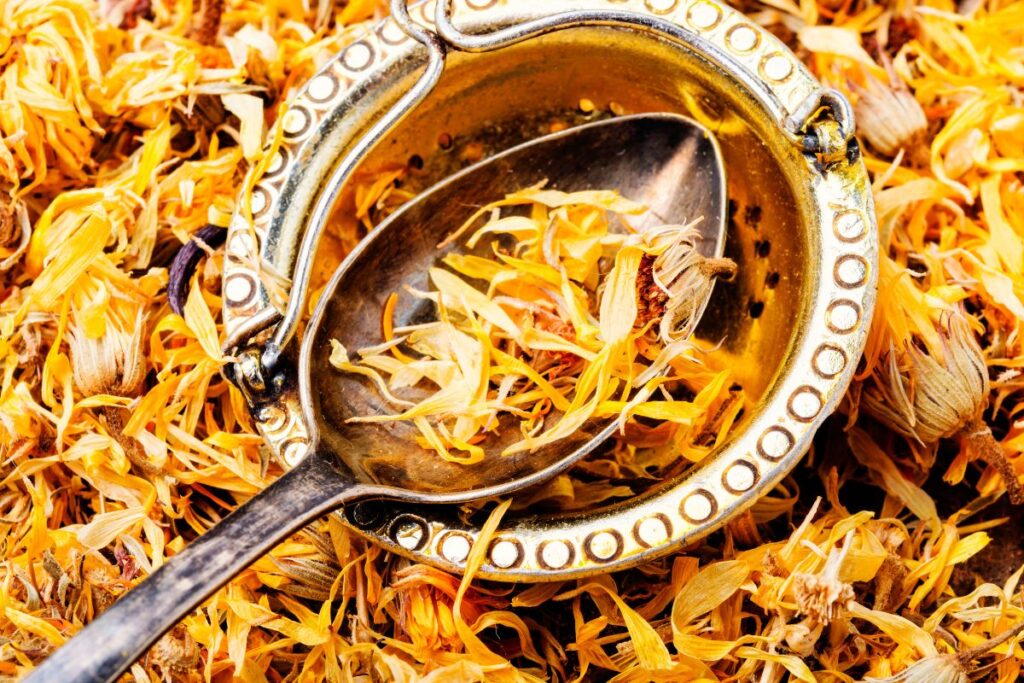
Side effects of calendula
Calendula is not recommended for human consumption:
- people with allergic reactions to other herbs, hay fever,
- allergic to vitamin A preparations,
- those with low blood pressure,
- pregnant women – not allowed.
Source:
https://www.healthline.com/nutrition/calendula-tea
Research:
https://pubmed.ncbi.nlm.nih.gov/19374166/
https://pubmed.ncbi.nlm.nih.gov/24798950/
https://pubmed.ncbi.nlm.nih.gov/27974009/
https://pubmed.ncbi.nlm.nih.gov/26978856/
https://pubmed.ncbi.nlm.nih.gov/17190444/
https://pubmed.ncbi.nlm.nih.gov/22899374/
https ://pubmed.ncbi.nlm.nih.gov/32039173/
https://pubmed.ncbi.nlm.nih.gov/16677386/
https://pubmed.ncbi.nlm.nih.gov/30289008/
https://pubmed.ncbi.nlm.nih.gov/22789794/
https://www.ncbi.nlm.nih.gov/pmc/articles/PMC3768360/
https://www.ncbi.nlm.nih.gov/pmc/articles/PMC3262537/
https://pubmed.ncbi.nlm.nih.gov/31349650/
https://pubmed.ncbi.nlm.nih.gov/24969522/ xml-ph-0014@deepl.intern
Associative photos © Canva.

